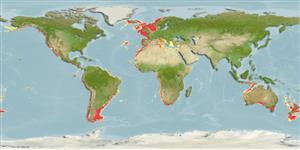Classification / Names
Common names from other countries
Main reference
Size / Weight / Age
Max length : 193 cm TL male/unsexed; (Ref. 40637); 195.0 cm TL (female); common length : 160 cm TL male/unsexed; (Ref. 9258); max. published weight: 44.7 kg (Ref. 40637); max. reported age: 55 years (Ref. 6871)
Length at first maturity
Lm 145.5, range 120 - 185 cm
Environment
Marine; benthopelagic; oceanodromous (Ref. 51243); depth range 0 - 1100 m (Ref. 26346), usually 2 - 471 m (Ref. 43939)
Climate / Range
Subtropical, preferred 18°C (Ref. 107945); 70°N - 58°S, 111°E - 37°E
Distribution
World-wide in temperate waters (Ref. 58085). Western Atlantic: southern Brazil to Argentina. Eastern Atlantic: Iceland, Norway, Faeroe Islands, British Isles to the Mediterranean and Senegal; Namibia to South Africa (Western Indian Ocean). Western Pacific: Australia and New Zealand. Eastern Pacific: British Columbia (Canada) to southern Baja California, Gulf of California; Peru and Chile. Questionable records in Ivory Coast, Nigerai, Gabon to Congo Dem Rep and Laysan Is. (Hawaii) (Ref 244).
Countries | FAO areas | Ecosystems | Occurrences | Introductions
Short description
Dorsal
spines
(total): 0;
Dorsal
soft rays
(total): 0;
Anal
spines: 0;
Anal
soft rays: 0. A large houndshark with a long, pointed snout, a large mouth, and small blade-like teeth; 2nd dorsal about as large as anal fin and terminal caudal lobe as long as rest of fin (Ref. 5578). Greyish above, white below; young with black markings on fins (Ref. 5578).
IUCN Red List Status (Ref. 115185)
Human uses
Fisheries: highly commercial; gamefish: yes; aquarium: public aquariums
Tools
Special reports
Download XML
Internet sources
Estimates of some properties based on models
Phylogenetic diversity index
PD50 = 1.0000 many relatives (e.g. carps) 0.5 - 2.0 few relatives (e.g. lungfishes)
Trophic Level
4.3 ±0.1 se; Based on diet studies.
Resilience
Very Low, minimum population doubling time more than 14 years (rm=0.033; tmax=55; Fec=6-52)
Vulnerability
High to very high vulnerability (74 of 100)
Price category
